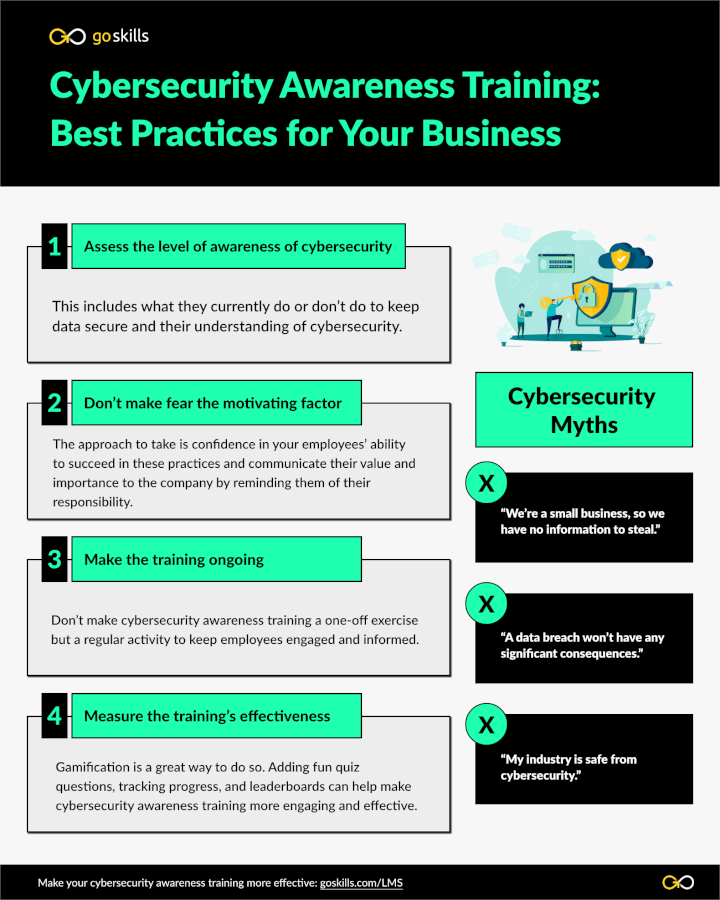If you ask most IT departments the simple question: How does cybersecurity work? You’ll probably get a series of different answers, but the general idea is that humans are the weakest link in the cybersecurity chain. Research has shown that 82% of data breaches involved a “human element.” But as grim as that may sound, it’s also possible to turn that weak link into a powerful first line of defense.
The key to accomplishing that is by conducting a robust cybersecurity awareness training program. If you give your employees cybersecurity skills and the knowledge they need to spot the warning signs of a cyber attack, you could help empower your employees to keep your company’s sensitive data secure.
Why small businesses need cybersecurity training
If you run a small to medium-sized business, cybersecurity training may seem like an unnecessary concern. The perception is often that cybersecurity training and awareness is only for large businesses since they seem to have more at stake than your business. However, this is far from true.
Your small business is as vulnerable to cyber threats as a large organization. The reason for this is that larger businesses typically have more resources to spend on cybersecurity awareness, and train their staff on these important principles. Small businesses may have smaller budgets and often, limited knowledge about the risks involved. This makes them a more significant target for cyber attacks.

How does cybersecurity work?
Cybersecurity helps keep your business safe using technology, processes, and preventive measures against any cyber threats or malicious software. This is usually a more defense-first approach, keeping anything harmful away from your data and out of your systems.
Awareness is a crucial first step as far as cybersecurity goes.
It involves preparing employees for potential cybersecurity attacks, training them on keeping assets secure, and equipping them with the right cybersecurity software, including a VPN that changes location, to make the right choices and avoid malicious software attacks.
Don’t believe these myths about cybersecurity!
Myth #1: We’re a small business, so we have no information to steal
Small businesses DO have valuable information! This includes employee and customer data, personal and financial information, and potential trade secrets. All of this information is extremely sensitive and needs to be protected. In the wrong hands, it can result in significant damage to your business and the people involved (both customers and employees).
Myth #2: A data breach won’t have any significant consequences
False! Data breach regulations are now a lot more stringent, regardless of where you operate. In fact, there’s really no getting away from them if you’re running a business, regardless of its industry and size. The cost of ignoring cybersecurity awareness can be more costly than you think in terms of penalties, fees, and reputation costs.
Myth #3: My industry is safe from cybersecurity
Unfortunately, there’s no industry that is immune to cybersecurity risks. Every industry has sensitive information, trade secrets, and valuable data that is at risk of being stolen or misused via a cyber attack. With this in mind, it’s important to protect your data and train your employees on cyber security awareness.

Best practices for cybersecurity awareness training
Now that you've understood the need for a cybersecurity awareness program for your employees, how do you go about implementing one? With 4 basic steps:
1. Evaluate your employees' cybersecurity awareness levels
Before you begin training, it is important to measure and understand the current knowledge levels of your employees as far as cybersecurity awareness goes. This includes what they currently do or don’t do to keep data secure, and what their understanding is of cyber security importance.
This is because cyber security awareness isn’t just for upper management. All levels of employees need to have the responsibility of understanding and adopting cybersecurity awareness.
2. Don’t make fear the motivating factor
Although fear might be a powerful motivator, in the case of cyber security awareness, it can be counterproductive. This is because it may hamper your employees from coming forward about past issues or slip-ups that happen due to fear of corrective action and consequences.
The approach to take is one of confidence in your employees' ability to succeed in these practices, and communicate their value and importance to the company by reminding them of their responsibility.
3. Make the training ongoing
Learning about cybersecurity can seem complex, and information overload does more harm than good. Instead, avoid overloading employees with information that they won’t retain.
Don’t make cybersecurity awareness training a one-off exercise but a regular activity to keep employees engaged and informed. Flexible, ongoing training allows for better information retention and makes it less burdensome for employees and for the team that facilitates the lessons.
4. Measure the training's effectiveness
Gamification is a great tool to measure the effectiveness of training. By adding fun quiz questions, tracking progress, and leaderboards, you can help make cybersecurity awareness training more engaging and effective.
Bonus tip: Get a free customizable cybersecurity course template
Since any organization can become a target of data breaches or cyber-attacks, it’s important to take these important steps to safeguard your business. A lack of financial resources should not be a barrier to securing your business' proprietary information and other data — there's just too much at risk. Most importantly, you need training that is relevant and specific to your industry and team, not some boring cookie-cutter video that will leave employees feeling like they've wasted their time.
GoSkills’ business customers have free access to our course template gallery (including a ready-to-use online course template for cybersecurity) that makes customizing essential employee training easy and effective. Interested in learning more about how your business can access these types of resources? Sign up for a free, no-commitment business account.Customized training for your team
Access course templates with a GoSkills business account — no credit card required!
Check out the templates



